Themed collection Artificial Photosynthesis

Introduction to a themed issue of Chemical Society Reviews on artificial photosynthesis
Guest editors Gary W. Brudvig and Sebastiano Campagna introduce the artificial photosynthesis themed issue of Chemical Society Reviews.

Chem. Soc. Rev., 2017,46, 6085-6087
https://doi.org/10.1039/C7CS90096A
Mechanisms of molecular water oxidation in solution and on oxide surfaces
Initial experiments on water oxidation by well-defined molecular catalysts were initiated with the goal of finding solutions to solar energy conversion.
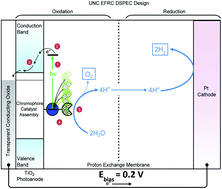
Chem. Soc. Rev., 2017,46, 6148-6169
https://doi.org/10.1039/C7CS00465F
O–O bond formation in ruthenium-catalyzed water oxidation: single-site nucleophilic attack vs. O–O radical coupling
A review of water oxidation by ruthenium-based molecular catalysts, with emphasis on the mechanism of O–O bond formation.
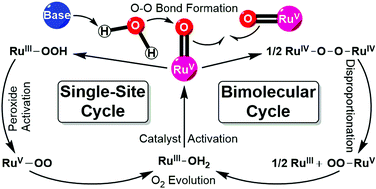
Chem. Soc. Rev., 2017,46, 6170-6193
https://doi.org/10.1039/C7CS00542C
Dye-sensitized photocathodes for H2 evolution
The arguments for converting sunlight and H2O to H2 to provide cleaner fuels and chemicals are very powerful.

Chem. Soc. Rev., 2017,46, 6194-6209
https://doi.org/10.1039/C7CS00322F
Frontiers of water oxidation: the quest for true catalysts
Development of advanced analytical techniques is essential for the identification of water oxidation catalysts together with mechanistic studies.
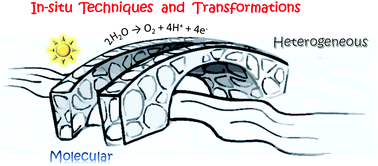
Chem. Soc. Rev., 2017,46, 6124-6147
https://doi.org/10.1039/C7CS00306D
How to make an efficient and robust molecular catalyst for water oxidation
The key factors to design an efficient and rugged molecular water oxidation catalyst (Mol-WOC) are reviewed and discussed.
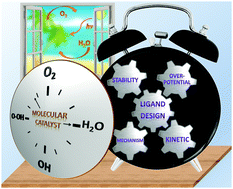
Chem. Soc. Rev., 2017,46, 6088-6098
https://doi.org/10.1039/C7CS00248C
Carbon dots as photosensitisers for solar-driven catalysis
This tutorial review discusses the rational development of structurally distinct carbon dots and their application in photocatalytic fuel synthesis.
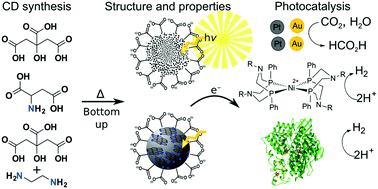
Chem. Soc. Rev., 2017,46, 6111-6123
https://doi.org/10.1039/C7CS00235A
Anchoring groups for photocatalytic water oxidation on metal oxide surfaces
The synthesis, binding modes, water stability, and electron-transfer dynamics are compared for carboxylate, phosphonate, hydroxamate, and silatrane anchoring groups.
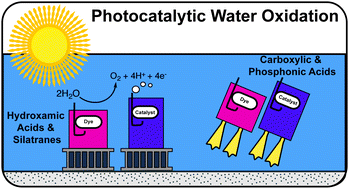
Chem. Soc. Rev., 2017,46, 6099-6110
https://doi.org/10.1039/C7CS00314E
About this collection
This collection of articles guest edited by Gary Brudvig (Yale University) and Sebastiano Campagna (University of Messina) aimed to summarize recent updated results on this high-valued topic seems to be quite useful to further push forward new breakthrough developments and applications in the next decade, and also to define a state-of-the-art for newcomers.
It is well known that artificial photosynthesis is one of the Holy Grails of modern science, with enormous potential to represent a decisive, sustainable energy resource for our world and civilization. Since it is based on solar enegy, that is equally spread out over the Earth, artificial photosynthesis would also be a democratic energy resource, contributing to alleviate not only energy problems, but also economic unbalances between countries, so promoting peace and development.
The artificial photosynthesis field has seen an impressive development in the last fifteen years. Interest on this topic has experienced a blooming growth, with more and more researchers devoting their efforts to face the problem. Homogeneous and heterogeneous systems have been prepared and studied. Novel light-harvesting antennae, charge-separation devices, and catalysts for water oxidation, molecular hydrogen production or carbon dioxide reduction, as well as the integration of such species in unique, functional (supramolecular) arrangements, have been designed. Hybrid homogeneous/heterogeneous systems, like photoelectrosynthetic cells based on (photo)electrodes, also including bio-derived subunits, have been prepared. New experimental techniques have also been successfully applied to the field.
Also of Interest
Artificial Photosynthesis: Faraday Discussion 198
One of the most promising technologies for solving the global environmental problems, artificial photosynthesis has seen many breakthroughs in various challenging approaches in recent years. Within decades, this can be expected to provide one of the most likely and realistic options to address the energy needs of society. This Faraday Discussion brings together current understanding of this rapidly advancing field. The book incorporates biological approaches, fundamental processes, molecular catalysts, visible light responsive semiconductor catalysts and inorganic assembly catalysts.